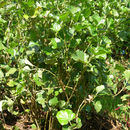Cyclicity
provided by IABIN
Jun/Dez
Brief Summary
provided by IABIN
Diagnosis A stout Pleurodema, with rounded snout, larger tympanum and lumbar twice larger as the eye diameter. Nostrils not terminal; tympanum large Ÿ of the eye diameter; skin slightly granular; larger vomerine teeth; fringes on sides of toes very reduced. characters used for definition of P. borellii and P. cinereum do not seem conclusive, and specimens are usually classified as one or another species following a distributional criterion more than a taxonomical one.
- author
- Esteban O. Lavilla
- editor
- Diego Arrieta
Distribution
provided by IABIN
Inhabits the Â?Selva de YungasÂ?, Â?Chaco SecoÂ?, and Â?Monte de Sierras y BolsonesÂ? ecoregions from Argentina; also found in Bolivia at Santa Cruz and Tarija Department.
- author
- Esteban O. Lavilla
- editor
- Diego Arrieta
Life Cycle
provided by IABIN
Perene
Molecular Biology
provided by IABIN
Óleo essencial
Reproduction
provided by IABIN
Vegetativa / Estacas (não produz sementes)
Diagnostic Description
provided by IABIN
Adult morphology Snout-vent of about 40-55 mm: males smaller than females. Triangular head wider than lager but somewhat painted, with rounded snout and nostrils not: terminal. The nostril-eye interval equal to the eye diameter, and slightly more than the distance between nostril and tip of snout. Interocular distance subequal to the upper eyelid and equal to the internarinal interval. Canthus rostralis round; loreal region concave. Maxillary teeth developed; vomerine teeth in two faint and diverging series between the choanae. Eye prominent, antero-laterally located, Tongue subcircular, notched behind. Tympanum oval, its horizontal diameter being more than 1/2 of the eye diameter. Supratympanic fold evident, going beyond the axilla. Fingers imperfectly fringed; rate of the finger lengths: II-IV-I-III. Subarticular tubercles round and prominent; metacarpal tubercles blunt. Toes fringed; webb indistinct. Sharp, conical subarticular tubercles. Inner and outer metatarsal tubercles shovel-shaped and very prominent. Tarsal fold present. When hindleg is adpressed, heel reaches the eye; when the femurs are bent at right angles to body the tibio-tarsal articulations touch. Skin with larger flat glanular patches on the dorsum, and lumbar glands long twice the eye diameter or more. Skin smoother on the belly. Discoidal fold present. Dorsally light brown with dark enlarged spots encircling the flat glandular patches. A W-shaped dark spot behind the eye. Dark transverse bands on the lumbar glands. Transverse dark brown bands on the limbs.
- author
- Esteban O. Lavilla
- editor
- Diego Arrieta
Behavior
provided by IABIN
BRASIL
Conservation Status
provided by IABIN
LC. Least Concern.
- author
- Esteban O. Lavilla
- editor
- Diego Arrieta
Comprehensive Description
provided by Smithsonian Contributions to Zoology
Pleurodema borellii (Peracca)
MATERIAL.—KU 160729 (two specimens dissected, both stage 37, SVLs 12.6, 14.2 mm). Collected from 18 km SSE Tafi del Valle, 1800 m, Tucumán, Argentina.
REFERENCE.—Cei (1980) described the larva.
GENERAL
- bibliographic citation
- Wassersug, Richard J. and Heyer, W. Ronald. 1988. "A survey of internal oral features of Leptodactyloid larvae (Amphibia: Anura)." Smithsonian Contributions to Zoology. 1-99. https://doi.org/10.5479/si.00810282.457
Pleurodema borellii
provided by wikipedia EN
Pleurodema borellii (common name: rufous four-eyed frog) is a species of frog in the family Leptodactylidae. It is found in northwestern Argentina and southern Bolivia. The taxonomic status of this species is uncertain, and it may be a junior synonym of Pleurodema cinerea.[2] It is abundant in Argentina, occurring in the Chaco-Yungas transition and montane grasslands on the eastern slopes of the Andes. Reproduction takes place in small permanent and temporary pools where pairs build floating foam nests. It is also found in disturbed habitats, including urban areas. No major threats to this species have been identified.[1]
References

- license
- cc-by-sa-3.0
- copyright
- Wikipedia authors and editors
Pleurodema borellii: Brief Summary
provided by wikipedia EN
Pleurodema borellii (common name: rufous four-eyed frog) is a species of frog in the family Leptodactylidae. It is found in northwestern Argentina and southern Bolivia. The taxonomic status of this species is uncertain, and it may be a junior synonym of Pleurodema cinerea. It is abundant in Argentina, occurring in the Chaco-Yungas transition and montane grasslands on the eastern slopes of the Andes. Reproduction takes place in small permanent and temporary pools where pairs build floating foam nests. It is also found in disturbed habitats, including urban areas. No major threats to this species have been identified.
- license
- cc-by-sa-3.0
- copyright
- Wikipedia authors and editors

